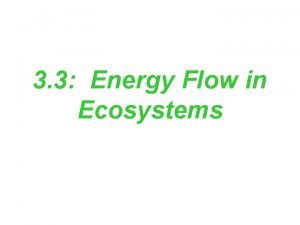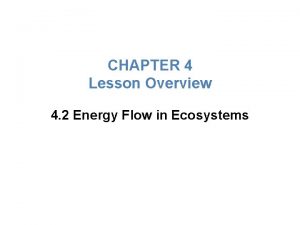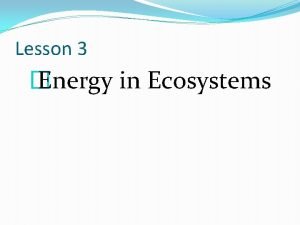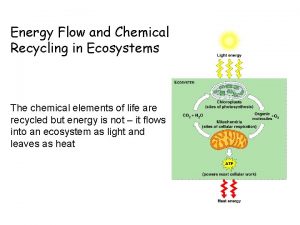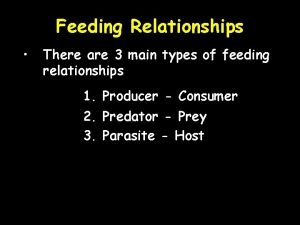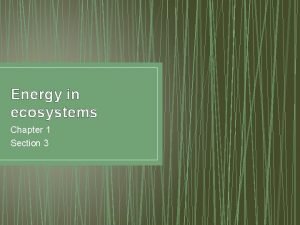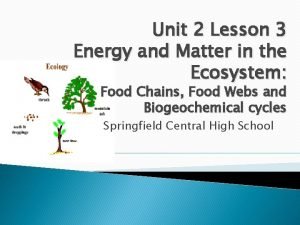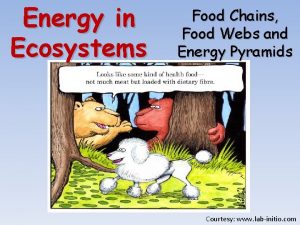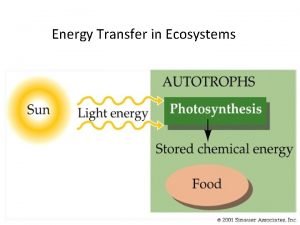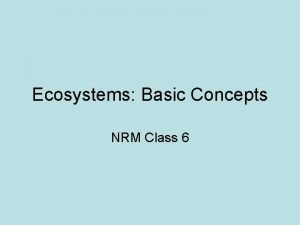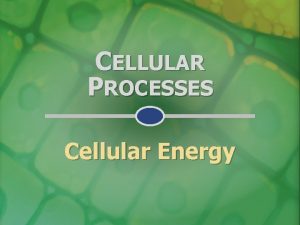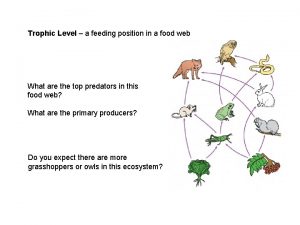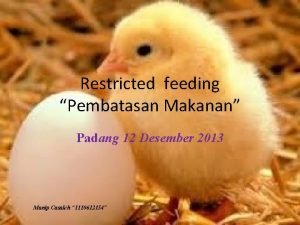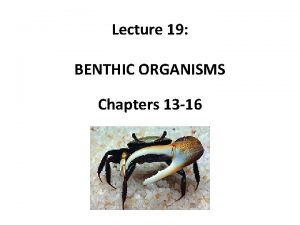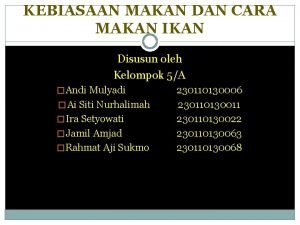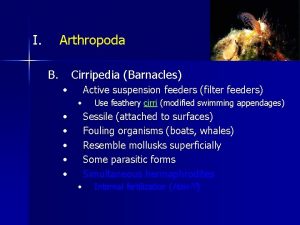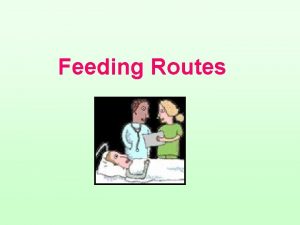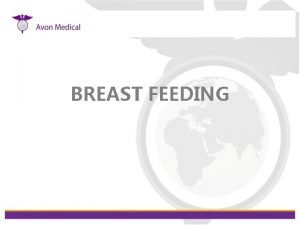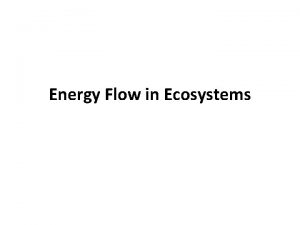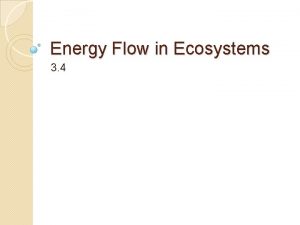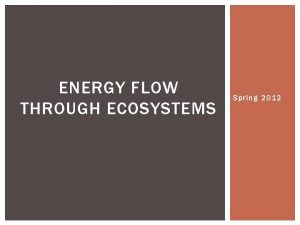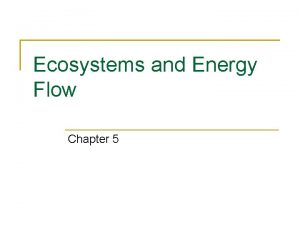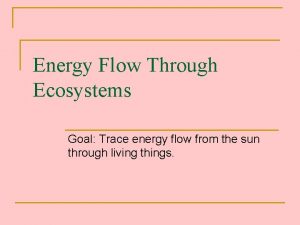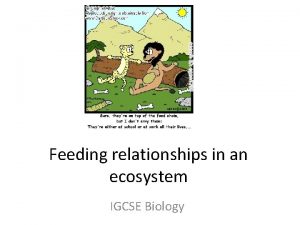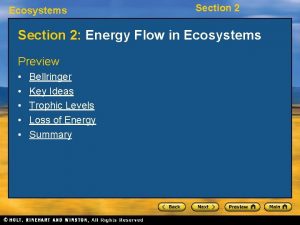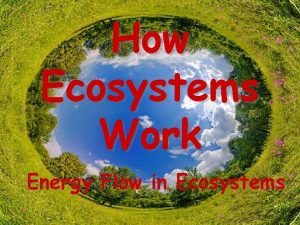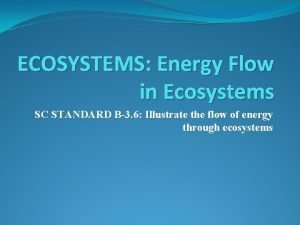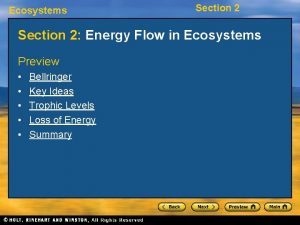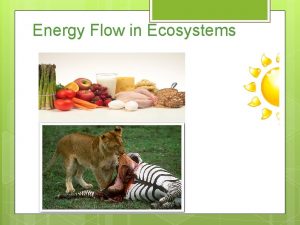3 3 Energy Flow in Ecosystems Feeding Relationships





























- Slides: 29

3. 3: Energy Flow in Ecosystems

Feeding Relationships energy flows through an ecosystem in one direction – from producers to various levels of consumers 2

food chain: simple energy path through an ecosystem 3

More Food Chains 4 4

any food chain starts with the producer – the group that collects the sun’s energy directly for use by the rest of the ecosystem microscopic consumer – herbivore (eats the producer) producer (trapped sunlight & stored food) 5

name the producer, consumers & decomposers producer decomposer consumer 6

food web: more realistic path through an ecosystem made of many food chains 7

8 8

9

food chain (just 1 path of energy) food web (all possible energy paths) 10

each level in a food chain or food web is a trophic level ~ means “feeding level” producers are ALWAYS the first trophic level ~ why called primary producers 11

this is how the sun’s energy enters the ecosystem producers use most of the energy they make for themselves 12

energy NOT used by producers can be passed on to organisms that can’t make their own energy (consumers) 13

consumers that eat producers are primary consumers ~ first (primary) ones to consume (eat) these are herbivores (plant eaters) always make up the second trophic level 14

Most of the energy the primary consumer gets from the producer is used by the consumer. Some of the energy is lost into the atmosphere as heat. 15 15

Some energy in the primary consumer is stored – not lost or used by the consumer itself. This energy is available for another consumer. 16 16

consumers that hunt & kill other consumers are called predators animals that are hunted & killed are called prey predator prey 17 17

consumer that eats another consumer for energy is called a secondary consumer ~ is the second one to consume (eat) may be a carnivore or a omnivore may be a predator or a scavenger 18

consumer that eats a consumer that already ate a consumer is called a tertiary (third level) consumer may be a carnivore or a omnivore may be a predator or a scavenger 19 copyright cmassengale 19

Each level depends on the one below it for energy! 20

“Rule of 10” only 10% of the energy found in one trophic level is passed to the next level up ~ also known as the “ 10% Rule” rest is used by the organism OR lost as heat this limits the number of organisms that can be supported at each level 21

Ecological Pyramids graphic representations of the relative amounts of energy or matter at each trophic level may be: ~ energy pyramid ~ biomass pyramid ~ pyramid of numbers 22

E N E R G Y Tertiary consumers top carnivores Secondary consumers small carnivores Primary consumers - Herbivores Producers - Autotrophs 23

Energy Pyramid 24

energy pyramids show: the amount of available energy decreases for higher consumers 25 25

amount of available energy decreases down the food chain 26 26

biomass: amount of organic matter found in a group of organisms in an ecosystem as you move up a food chain, both available energy and biomass decrease energy is transferred upwards but is diminished with each transfer 27

Biomass Pyramid 28

Pyramid of Numbers shows the number of individuals at each level 29
 A visual map of feeding relationships and energy flow
A visual map of feeding relationships and energy flow Specialized nutritional support
Specialized nutritional support Chapter 4 lesson 2 energy flow in ecosystems answer key
Chapter 4 lesson 2 energy flow in ecosystems answer key Which marine ecosystem contains the fewest producers
Which marine ecosystem contains the fewest producers Energy flow and chemical recycling in ecosystems
Energy flow and chemical recycling in ecosystems Primary consumer
Primary consumer Section 1 energy flow in ecosystems
Section 1 energy flow in ecosystems 3 main types of feeding relationships
3 main types of feeding relationships Ecological succession
Ecological succession Flow of energy vs flow of matter
Flow of energy vs flow of matter Section 3 energy in ecosystems
Section 3 energy in ecosystems Chapter 42 ecosystems and energy
Chapter 42 ecosystems and energy How does energy flow in an ecosystem
How does energy flow in an ecosystem Phosphorus cycle
Phosphorus cycle Lab food chains and energy in ecosystems
Lab food chains and energy in ecosystems Do birds eat squirrels
Do birds eat squirrels Energy flow through an ecosystem is ----- *
Energy flow through an ecosystem is ----- * Ecosystem definition class 6
Ecosystem definition class 6 Energy energy transfer and general energy analysis
Energy energy transfer and general energy analysis Energy energy transfer and general energy analysis
Energy energy transfer and general energy analysis Energy relationships and life 2
Energy relationships and life 2 Feeding positions in a food chain or web
Feeding positions in a food chain or web Penyakit masyarakat sasaran bintibluh
Penyakit masyarakat sasaran bintibluh Restricted feeding
Restricted feeding Tilapia feeding guide philippines
Tilapia feeding guide philippines Night of the scorpion talks about
Night of the scorpion talks about Mt washington pediatric hospital feeding clinic
Mt washington pediatric hospital feeding clinic Examples of benthic organisms
Examples of benthic organisms Cara memakan ikan
Cara memakan ikan Active suspension feeding
Active suspension feeding
